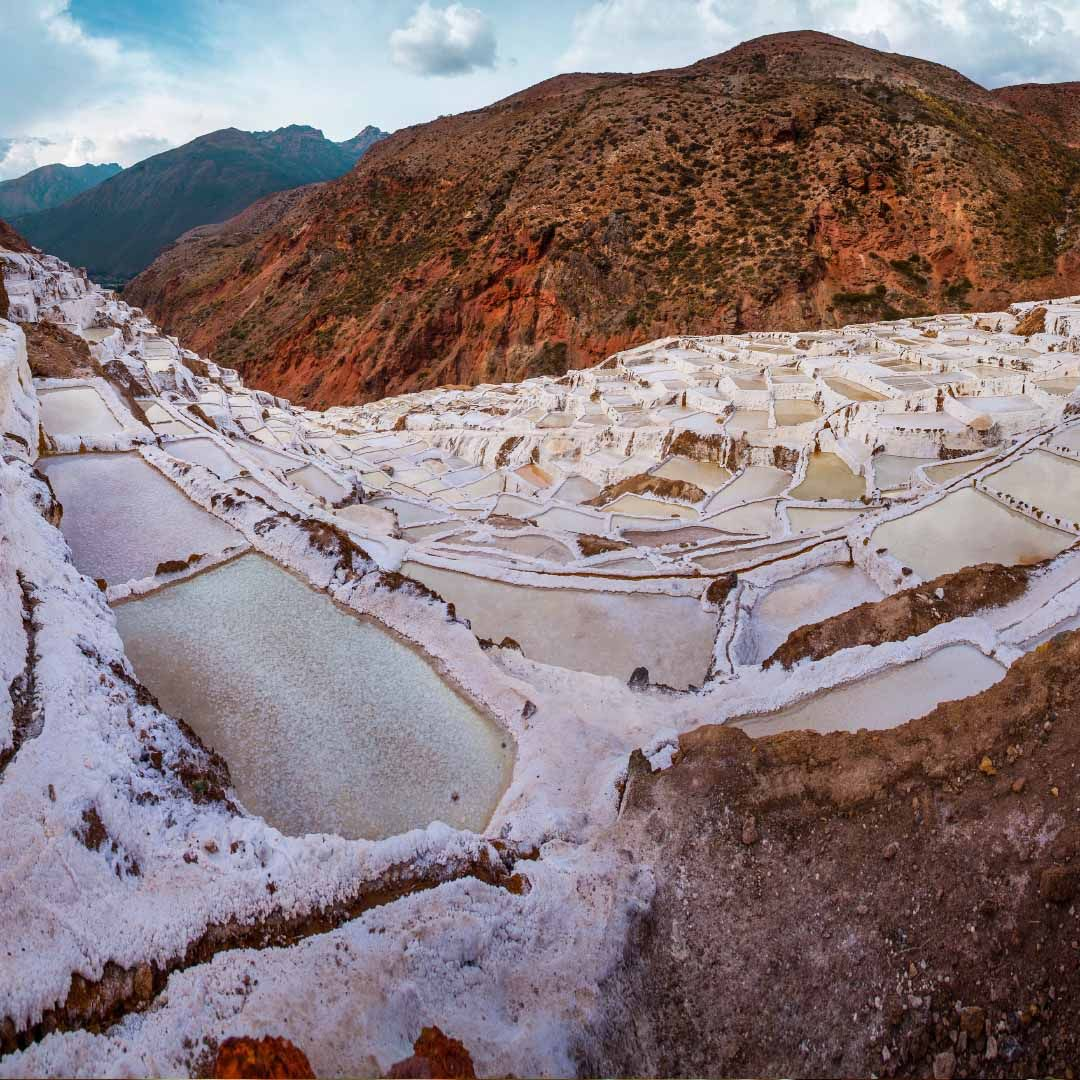Embark on a journey into the heart of Peru's rich cultural tapestry with a visit to the mesmerizing Salineras Maras. Nestled in the Sacred Valley, these ancient salt pans have stood as a testament to Inca ingenuity for centuries.
The intricate network of terraced pools paints a surreal picture against the Andean landscape, offering a glimpse into the fascinating traditions of salt harvesting dating back to pre-Inca times.
Join us as we delve into the history, the breathtaking vistas, and the enduring cultural significance that makes Salineras Maras an unmissable destination for those seeking the hidden treasures of Peru.
What will you find here?
- Salineras de Maras
- What are the salt mines of Maras?
- Where are the salt mines in Peru?
- What is the importance of the Maras salt mines?
- Salineras de Maras history
- Cultural significance
- Gourmet product
- Distance from Lima to Salineras de Maras
- How to get to Salineras de Maras
- Salineras de Maras elevation
- Salineras de Maras entrance
- Salineras de Maras ticket cost
- What is the best time of the year to visit Maras?
Salineras Maras
The salt from Maras is renowned for its unique pink hue and subtle flavor, a culinary delight sought after by chefs worldwide.
The varying shades of pink and white across the salt pans make for a spectacular visual experience, particularly during the dry season when the evaporation process is at its peak.
A visit to the Salineras de Maras is not just a visual treat but also an exploration of taste. The harvested salt adds a special touch to any dish, a flavor that carries the essence of the Andes.

What are the salt mines of Maras?
The salt mines of Maras, known as "Salinas de Maras," are located in the Sacred Valley of the Incas, near Cusco in Peru. These salt mines are an impressive sight, consisting of thousands of small pools carved into the mountainside. They have been in use since pre-Incan times, with salt being harvested in a traditional manner that has been passed down through generations.
The way these salt pans function is quite fascinating. A salty spring water source is directed into an intricate system of tiny channels that run down the mountainside. The water is funneled into numerous shallow, man-made pools. As the water evaporates, it leaves behind salt, which then crystallizes. The salt is subsequently collected by hand, a process that has remained largely unchanged for centuries.

Where are the salt mines in Peru?
The salt mines in Peru, specifically the famous Salinas de Maras, are located in the Sacred Valley of the Incas. This area is in the Urubamba province, which is part of the Cusco region in the southern part of the country. The mines are situated at an altitude of over 3,000 meters (about 10,000 feet) above sea level, near the town of Maras.
To give you a better geographical context, the Sacred Valley is a region in the Andes of Peru, close to the Inca capital of Cusco and the ancient city of Machu Picchu, making it a region rich in historical and cultural significance. The valley extends between the towns of Pisac and Ollantaytambo, and it's characterized by its fertile lands and significant Incan sites.
- Name of the mines: Salinas de Maras (Maras Salt Mines).
- Geographical area: Sacred Valley of the Incas.
- Altitude: Over 3,000 meters (approx. 10,000 feet) above sea level.

What is the importance of the Maras salt mines?
The Maras salt mines, or Salinas de Maras, hold significant importance both historically and in contemporary times, for several reasons:
- Cultural heritage: They represent an enduring legacy of pre-Incan and Incan engineering and culture. The salt mines have been in use for centuries, possibly dating back to 200 AD, showcasing the ingenuity of ancient civilizations in the Andes.
- Traditional salt harvesting: The method of salt extraction at Maras is largely traditional and manual, reflecting ancient practices. This traditional approach provides insights into the historical lifestyle and customs of the local communities.
- Economic significance: For local communities, the salt mines have been a source of economic sustenance. Each pool is owned and operated by local families, who depend on the sale of the harvested salt for their livelihood.
- Tourism: As a unique and picturesque site, Salinas de Maras is a significant tourist attraction in Peru, drawing visitors from around the world. This tourism contributes to the local economy and raises awareness of the region's cultural heritage.
- Geological interest: The salt mines are an example of a unique geological phenomenon. The saltwater springs emerge from within the Andes Mountains, making the site of both geological and environmental interest.
- Culinary appeal: The pink salt harvested from Maras is renowned for its mineral content and flavor. It has gained international recognition among chefs and gourmets, thereby contributing to Peru's culinary reputation on a global scale.
- Educational value: The mines provide educational value for visitors and researchers interested in traditional mining techniques, sustainable practices, and Andean history.
Salineras de Maras history
The history of the Salineras de Maras, or the Maras salt mines, is deeply intertwined with the cultural and historical tapestry of the Andes region in Peru. Here is an overview of their history:
Pre-Incan origins:
While it's often associated with the Inca, the use of the Maras salt pans likely predates them. There's evidence suggesting that salt has been harvested at Maras since pre-Incan times, possibly as early as 200 AD.
Incan expansion and use:
The Incas expanded and extensively used the salt pans. They developed a sophisticated network of channels to manage the flow of the saltwater spring that feeds the pans. This system was vital for salt production, which was a valuable commodity in the Incan economy.
Spanish conquest:
During the Spanish conquest and the colonial period, the Maras salt mines continued to be an important economic resource. The Spaniards imposed taxes and regulations on salt production, integrating it into the colonial economy.
Traditional ownership and methods:
Despite these historical upheavals, the traditional methods of salt extraction at Maras have remained largely unchanged for centuries. Families in the local community traditionally own individual salt pans. Each family is responsible for the maintenance and harvesting of their salt pans, a practice that has been passed down through generations.
Modern times and tourism:
In recent times, while continuing to serve as a source of livelihood for local families, the Maras salt mines have also become a significant tourist attraction. Visitors are drawn to the picturesque site, where thousands of individual salt pans cascade down the hillside, creating a stunning landscape.
Cultural significance
Today, the Salineras de Maras not only represent an ancient method of salt production but also stand as a symbol of enduring Andean tradition and resilience. They are a testament to the ingenuity of the early inhabitants of the region and their ability to adapt to and make use of their natural environment.
Gourmet product
The unique pink salt harvested from the pans, rich in minerals and with a distinctive taste, has gained international fame. It's now a sought-after gourmet product worldwide, further adding to the cultural and economic significance of the Maras salt mines.
Distance from Lima to Salineras de Maras
The distance from Lima, the capital city of Peru, to the Salineras de Maras (Maras Salt Mines) varies depending on the mode of transportation and the specific route taken. However, as a general guide:
- By air: The most common way to travel from Lima to the Maras Salt Mines is to fly from Lima to Cusco. The flight typically takes about 1 hour and 20 minutes. The Salineras de Maras are located about 40 kilometers (25 miles) north of Cusco. This part of the journey, from Cusco to the salt mines, can take around 1 to 1.5 hours by car or bus.
- Total distance: The straight-line (aerial) distance from Lima to Cusco is approximately 570 kilometers (355 miles). The additional overland distance from Cusco to the Maras Salt Mines adds to this, making the total distance traveled more than this straight-line distance.
- Overland travel: Traveling entirely by land from Lima to the Salineras de Maras is a much longer journey. It involves a bus ride from Lima to Cusco, which can take about 21 hours, followed by a shorter trip from Cusco to the salt mines.

How to get to Salineras de Maras
To visit the Salineras de Maras (Maras Salt Mines) from Cusco, which is the usual starting point for most tourists, you can follow these steps:
- Travel from Cusco to Urubamba or Ollantaytambo:
-
- You can take a bus or a shared van (colectivo) from Cusco to Urubamba or Ollantaytambo. These are towns in the Sacred Valley and are closer to Maras.
- Alternatively, you can hire a taxi or arrange a private tour from Cusco directly to Maras.
- From Urubamba or Ollantaytambo to Maras:
- In Urubamba or Ollantaytambo, you can find taxis or small vans that will take you to Maras. This is a common route for tourists, so transportation is usually readily available.
-
- If you’re part of a tour group, transportation will likely be included in your tour package.
- Maras to the Salt Mines:
- From the town of Maras, you can either hike or take a taxi to the actual salt mines. The hike is scenic but can be a bit challenging for those not accustomed to the altitude.
- Taxis are available in Maras and can take you directly to the entrance of the salt mines.
- Entrance fee:
- There is typically an entrance fee to visit the salt mines, so be prepared to pay this small fee.
-
- Altitude: Maras is at a high altitude, so it’s important to acclimatize in Cusco before attempting any hikes.
- Weather: The weather can change rapidly, so dress in layers and be prepared for sun, wind, and rain.
- Time: Give yourself at least a half-day for this trip, especially if you plan to spend time exploring the mines and taking photos.
- Guided Tours:
-
- Many visitors opt for guided tours which can be booked in Cusco. These tours often include transportation and a guide who can provide information about the history and operation of the salt mines.

Salineras de Maras elevation
The Salineras de Maras, also known as the Maras Salt Mines, are located at an elevation of approximately 3,300 meters above sea level. This altitude is typical for many locations in the Andes, including the Sacred Valley where Maras is situated.
Visitors should be aware of the potential effects of high altitude, such as altitude sickness, and take appropriate precautions, especially if they are not acclimatized to high elevations.
This may include spending a few days in Cusco, which is slightly lower in elevation, before visiting Maras and other high-altitude sites in the region.
Salineras de Maras entrance
As of 2024, to visit the Salineras de Maras (Maras Salt Mines), there is an entrance fee that is not included in most tour packages. The fee for entering the salt mines is 10 soles (3 USD) per person.
It's important to carry some cash for this fee, as well as for any additional expenses or souvenirs you might want to purchase during your visit. Keep in mind that prices and policies can change, so it's always a good idea to verify the latest information closer to your visit.
Salineras de Maras ticket cost
As of 2024, the entrance fee for the Salineras de Maras (Maras Salt Mines) is 10 soles (3 USD) per person. Remember to bring cash for the entrance fee, as well as for any other expenses during your visit. Keep in mind that prices can change, so it's advisable to check for the most current information closer to the time of your visit.

What is the best time of the year to visit Maras?
The best time to visit Maras, particularly the Salineras de Maras (Maras Salt Mines), is during the dry season, which runs from May to October. Here's why this period is ideal:
- Weather: The dry season offers sunny days and mild temperatures, making it more comfortable for exploring the outdoor sites.
- Salt production: This is the time when the sun efficiently evaporates the water in the salt ponds, allowing you to witness the salt harvesting process more vividly. The salt pans are more likely to be filled with salt crystals during this period, offering a spectacular view.
- Accessibility: The dry weather makes access to the mines easier, as the roads and paths are less likely to be muddy or slippery.
- Photography: The bright, sunny days provide excellent lighting for photography, enhancing the natural beauty of the salt pans against the Andean landscape.












